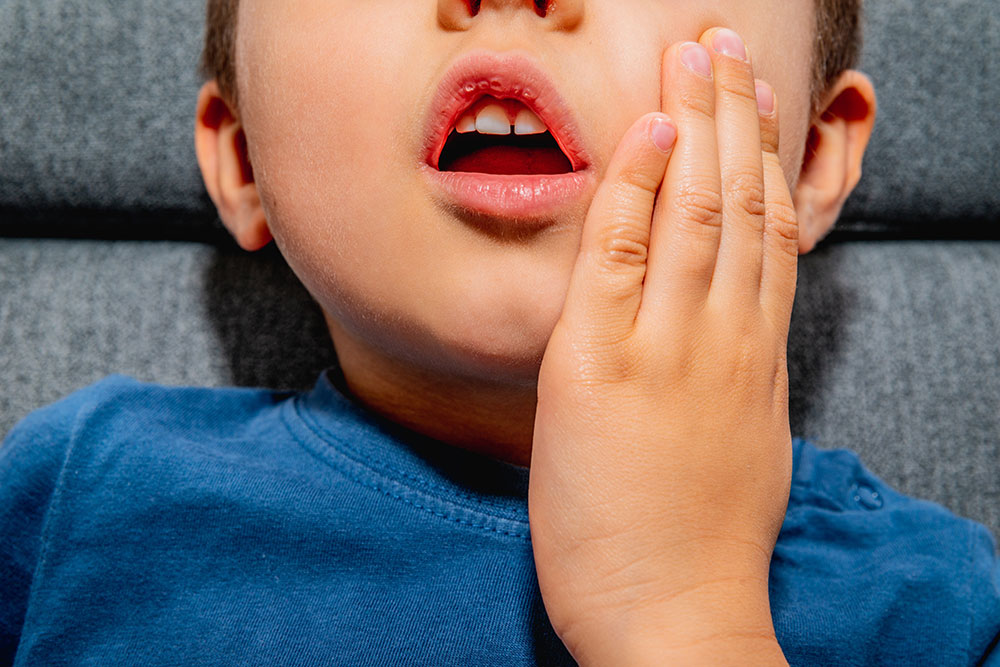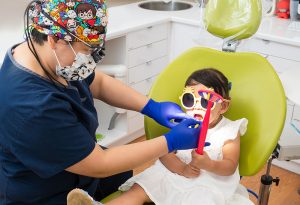ABNORMAL ERUPTION
Ectopic eruption is a malposition of a permanent tooth bud resulting in the tooth erupting in the wrong place. The most common areas are the maxillary first molars, followed by the maxillary cuspids.
First permanent molar – Ectopic eruption is due to mesial positioning or inclination of the tooth into the second primary molar. This can result in delay of eruption of the first permanent molar and resorption of the distal root of the second primary molar. Treatment consists of:
- Placement of separating elastics, brass ligature wire or orthodontic appliance to distalise the first molar.
- Contour the distal of the second primary molar.
- Extraction of the second primary molar and placement of a distalising appliance.
Cuspid – Ectopic eruption is due to the mesial inclination of the permanent cuspid becoming impacted in the palate or impacting on the root of the lateral incisor. A clinical indicator is distal tipping of the lateral incisor crown. Panoramic, periapical and occlusal radiographs are used to determine the position of the cuspid relative to the lateral incisor. Treatment consists of:
- Extraction of the primary cuspid.
- Orthodontic lassoing of the permanent cuspid.
EXTRA/MISSING TEETH
Missing Teeth
The normal number of baby teeth is 20 and these are all lost to make way for the permanent (adult) teeth. The normal number of adult teeth is 32; this includes four wisdom (third molar) teeth. The transition to the permanent dentition starts at around six years of age and continues until around 12 years of age. It generally occurs in two stages. First the upper and lower front incisor (8) teeth are lost and replaced with permanent incisors and the four six year old molars erupt behind the baby molars. This is usually completed by eight years of age. In the second stage the remaining baby (12) teeth are lost and replaced by 12 adult teeth, eight premolars and four second molars.
Some children do not develop a full set of permanent teeth. The most commonly missing teeth are the upper lateral incisors, second premolars and third molars (wisdom teeth). Most children who have missing teeth will only have one or two missing teeth. Children who have more than this number missing may have a special genetic condition called ectodermal dysplasia.
Supernumerary Teeth (Extra Teeth)
Teeth are usually lost symmetrically in pairs and if one side is lagging behind then it is best to investigate with your dentist early rather than later. Occasionally an extra (supernumerary) tooth may be blocking the eruption path of the adult tooth causing a problem with both the loss of the baby tooth and the alignment and proper development of the adult tooth. This problem is best dealt with earlier rather than later and is most common in the upper incisor area.
Over-Retained Teeth
Sometimes baby teeth just hang around for too long. They become loose then tighten again as the emerging adult tooth becomes increasingly deflected from an ideal position in the dental arch. Some baby teeth just seem to be hanging by a thread making eating and brushing very difficult and painful. Plaque can build up around the gum line of both the baby tooth and the emerging adult tooth placing it at risk of early decay or at least mineral loss. The gums may bleed excessively on brushing causing distress.
Patience is the first course of action as many of these baby teeth will eventually be lost naturally. If pain and gum infection become a problem so that eating and brushing are an ordeal then removal of the tooth may be necessary. If the baby tooth has become quite tight again and the adult tooth is deflected from an ideal position then it may be necessary to remove the baby tooth. Some children suffer from this problem repeatedly while others will have an isolated problem with only one or two teeth affected. The most common position is in the lower two central incisors, commonly referred to as “shark teeth” as it appears as 2 rows of teeth in the mouth. The next most common is the upper two central incisors.
The loose baby tooth can sometimes be removed by applying some topical anaesthetic gel to the gum line around the tooth. The gel is flavored and after three to five minutes causes the gum to become ‘numb’ or ‘frozen’. It is then possible to pinch the tooth away with some light pressure and a piece of gauze. Parents may be able to do this for their child by using a preparation like ‘bonjela’ to ‘numb’ the gum first. If the tooth does not come away easily it may be quite painful for the child if you persist. Dentists are generally quite experienced at determining whether or not local anaesthetic will be necessary.
A firm baby tooth may require the use of local anaesthetic. As paediatric dentist, we will explain this to your child in a way to help them feel confident and comfortable.
Children respond well to a kind approach and firm instructions such as remaining very still and opening wide. They understand the importance of being safe and minimising the discomfort. Your dentist has developed a sensitive and positive approach to the use of local anaesthetic and is very experienced in safe and reliable injection techniques. It is best to keep the answers to your child’s questions brief and simple. If you are unsure about the precise nature of the procedure then it is best to tell your child to ask their dentist for information on the day of the procedure.



